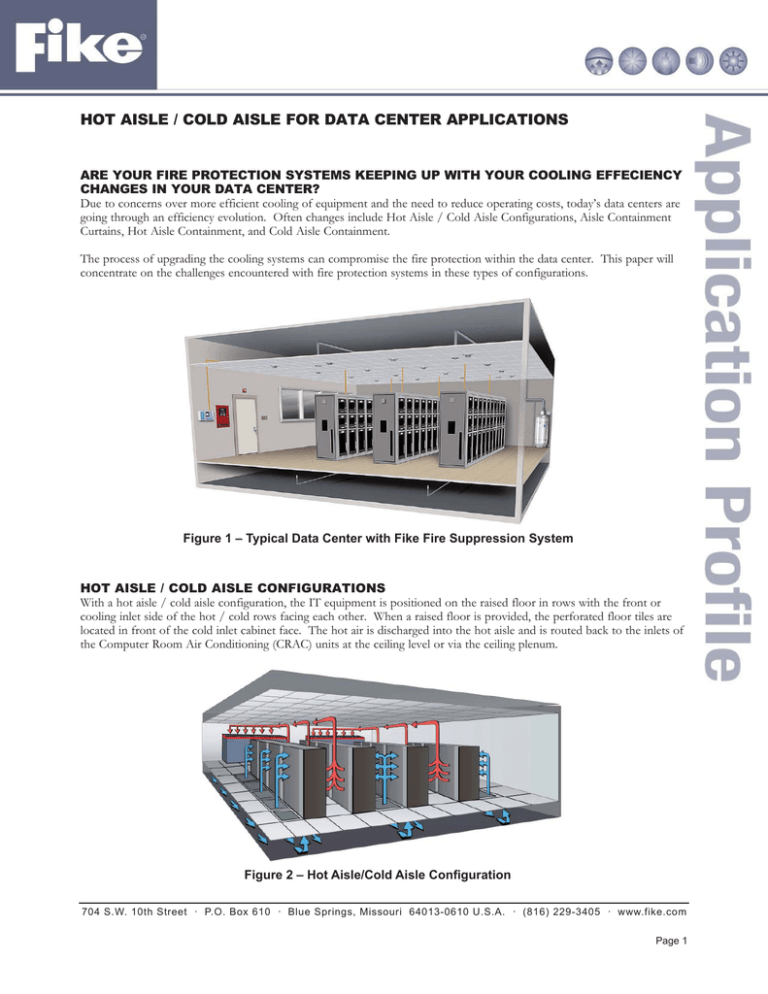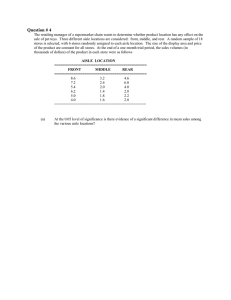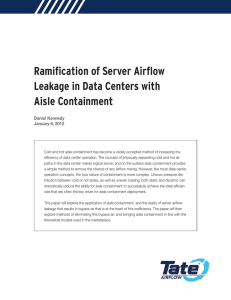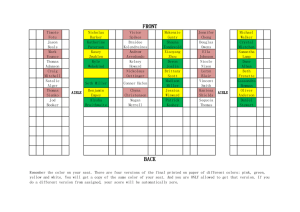
HOT AISLE / COLD AISLE FOR DATA CENTER APPLICATIONS
ARE YOUR FIRE PROTECTION SYSTEMS KEEPING UP WITH YOUR COOLING EFFECIENCY
CHANGES IN YOUR DATA CENTER?
Due to concerns over more efficient cooling of equipment and the need to reduce operating costs, today’s data centers are
going through an efficiency evolution. Often changes include Hot Aisle / Cold Aisle Configurations, Aisle Containment
Curtains, Hot Aisle Containment, and Cold Aisle Containment.
The process of upgrading the cooling systems can compromise the fire protection within the data center. This paper will
concentrate on the challenges encountered with fire protection systems in these types of configurations.
Figure 1 – Typical Data Center with Fike Fire Suppression System
HOT AISLE / COLD AISLE CONFIGURATIONS
With a hot aisle / cold aisle configuration, the IT equipment is positioned on the raised floor in rows with the front or
cooling inlet side of the hot / cold rows facing each other. When a raised floor is provided, the perforated floor tiles are
located in front of the cold inlet cabinet face. The hot air is discharged into the hot aisle and is routed back to the inlets of
the Computer Room Air Conditioning (CRAC) units at the ceiling level or via the ceiling plenum.
Figure 2 – Hot Aisle/Cold Aisle Configuration
704 S.W. 10th Street · P.O. Box 610 · Blue Springs, Missouri 64013-0610 U.S.A. · (816) 229-3405 · www.fike.com
Page 1
COLD AISLE CONTAINMENT CURTAINS
Containment curtains have long been used as a cooling method and are one of many solutions to conserving energy. The
IT equipment may be located on a raised floor plenum and arranged so that the exhaust rows are facing each other. In a
raised floor design the perforated floor tiles throughout the room are located so that the tiles used in the exhaust (hot) aisle
are not perforated. The vinyl curtains are installed around the cold aisle to prevent recirculation of exhausted hot air back
into the IT equipment by directing it to the CRAC/CRAH equipment. As part of this, the existing fire protection systems
need to be reviewed with the local Authority Having Jurisdiction (AHJ).
Figure 3 – Cold Aisle Curtain Containment
When vinyl containment curtains are in an IT room protected with a Fike Clean Agent Fire Suppression System, a
UL listed Electric Thermal Link (ETL) may be used because the containment curtains can act as obstructions to the
free flow of the agent. When the clean agent suppression system operates, agent is discharged from all system nozzles
simultaneously. The ETLs are wired to the fire suppression detection control panel. When the panel receives a confirmed
indication from the smoke detectors, a signal is sent to all the wired ETLs, releasing all the containment curtains
simultaneously. The mounting hardware should also be furnished with 18-inch stainless steel lanyards. The stainless
steel cables prevent the curtain assembly from falling and hitting personnel and/or IT equipment. In most applications
existing clean agent suppression nozzle locations may be acceptable and will provide the required homogeneous agent
concentration mix.
NFPA 2001 (5.3.6) 2012 Edition requires that all HVAC equipment be shut down prior to the discharge of a Clean Agent
Fire Suppression System. If the HVAC continues to operate, and the above ceiling is used as a return air plenum, the
volume of the above ceiling plenum needs to be included in the overall room volume and additional clean agent needs to
be added. If the plenum space is designed with non-combustible construction material, above ceiling detectors are not
normally required.
In addition, smoke detectors will need to be re-spaced accordingly, taking into account the new containment areas. Smoke
detectors will need to have their location reviewed in relation to the containment curtain. The smoke detector spacing also
needs to be evaluated due to the changes in the airflow patterns. The hot aisle becomes a prime detector location due to
the exhaust from the IT equipment.
Page 2
HOT AISLE CONTAINMENT
Hot aisle containment is similar to the containment curtains described above, but allows for higher density cooling.
This form of containment completely separates supply and return air paths. The hot aisle is sealed off using doors and
transparent ceiling tiles that extend the width of the hot aisle.
Figure 4 – Hot Aisle Containment Design
Because of limited space and high air flow, consideration should be given to the use of very early warning air sampling
detection for the release of the Fike Clean Agent Fire Suppression System. This early warning smoke detection will provide
smoke sampling of the Hot Aisle Containment area from the sub-floor or ceiling. When a fire is detected, clean agent
suppression is ideal for protecting hot aisle containment because of the speed of extinguishment with rapid homogenous
agent mix.
COLD AISLE CONTAINMENT
In a cold aisle configuration the contained space returns the hot equipment exhaust to the room, and/or ceiling plenum and
then back to the CRAC unit intake. If the hot air is directed to the ceiling plenum it will require additional fire suppression
agent to protect the added volume of the non-combustible ceiling plenum area.
Figure 5 – Cold Aisle Containment Design
Page 3
When the design only vents to the main room, as illustrated in Figure 5, it is not required to add the ceiling plenum volume
to the room volume in designing the appropriate fire suppression and detection.
In these types of scenario, smoke detector locations need to be evaluated to determine if the devices are taking advantage
of new return air paths to provide the best possible operation.
SUMMARY OF THE FACTORS THAT MUST BE CONSIDERED
Obstructions that affect:
• clean agent nozzle clearance and coverage
• smoke detector coverage and spacing
Inadequate automatic obstruction removal (plastic curtain applications) that affect:
• clean agent nozzle clearance and coverage
• clean agent concentration development
Multiple areas of containment (separate volumes) that affect:
• clean agent concentration development
(will clean agent concentration develop within each area of containment?)
• clean agent nozzle area coverage and agent distribution
• smoke detector coverage and spacing (detectors in every area of containment?)
• smoke detection cross-zoning sequences or verified detection logic considered
High temperatures that affect:
• clean agent concentration
• smoke detection operation
High airflow velocities that affect:
• clean agent distribution
• smoke detection performance
CONCLUSION
Numerous designs of hot aisle / cold aisle technology are available in the market today and we can expect new and
improved approaches will continue to be introduced.
When making changes to your cooling system with the various Hot/Cold aisle containment air flow configurations, it is
important to make sure you do not adversely affect the performance of the Fike Clean Agent Fire Suppression System
or the Fike Detection / Control system. All factors listed above must be considered to ensure your system is not
compromised by modifications to the facility.
It is important to speak with a Fike qualified designer of fire suppression equipment to make sure your system will operate
as intended and meet all code requirements.
R
Copyright © Fike Corporation All Rights Reserved.
Form No. FSAP 001 February, 2012 Specifications are subject to change without notice.
Page 4






